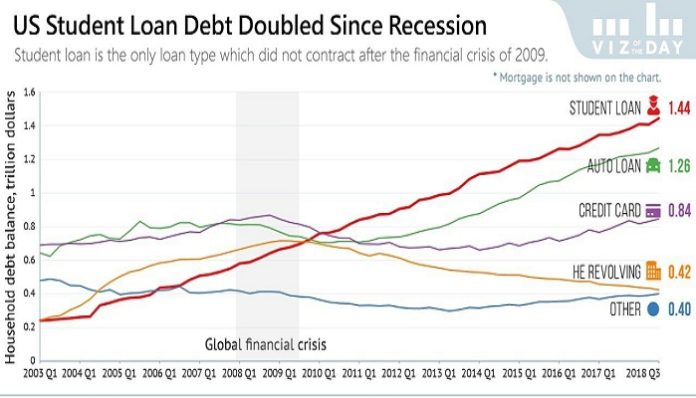Pak Sahafat – On average, every American has nearly $29,400 in student debt when they graduate. Student debt is the second largest household debt in the United States.
The job situation in America is progressing in such a way that choosing the university path is considered the best option for young people. Due to the advancement of technology and the increasing importance of specialized jobs, it is more difficult to earn money without a degree.
Today, college graduates in the US earn on average 80% more than those with only a high school diploma. As a result, education is more expensive than ever and the importance of a university degree is greater than ever. As a result, young Americans are faced with a dilemma: burdened with loans they can’t afford to pay back, or forgo the benefits of a college degree.
Today, more than 44 million Americans, or 12 percent of the US population, owe student loan repayments. Student loans are used to pay for students’ educational expenses, including university fees, food, and accommodation. It seems that this plan is necessary to create the ability to study in different strata of America. But the inability to secure repayment of student loans and student debt has become an important issue in America. According to some economic experts, student loans destroy not only the lives of students in the years after graduation, but also the macro economy. The total student loan debt reaches more than 1.7 trillion dollars, which shows a 3-fold growth in the last 15 years.
The average American has nearly $29,400 in student debt by the time they graduate. Student debt is the second largest household debt in the United States.
The cost of university education has faced a 200% growth since 1988; since it is not possible for many American families to pay for education, today nearly 70% of American students have to take out loans for their education. On the other hand, many of those who have to take a loan during their studies cannot afford to repay it.
A 2018 Brookings Institution study found that about 40 percent of students who took out loans in 2004 will default on their repayments by 2023. A 2008 report said some Americans are forced to leave the United States to escape student loans.
Danger lurking in American economic growth
Student loans affect macroeconomic parameters in the United States. For example, the housing market, which has recovered since the financial crisis in 2008, is experiencing growth on the supply side. But reports say student loan debt is setting Americans back home ownership by seven years. A seven-year delay may throw supply and demand out of balance in the coming years and create a new crisis in the US housing market.
In addition, people who received a loan during their student days do not want to receive other loans, such as car loans or credit cards, due to their inability to repay them. This problem makes the banks, which are an important pillar of the US economy; face a serious decrease in profits. On the other hand, when people buy less houses and cars and have less spending power, this issue can have negative effects on the economic growth of the United States and cause problems for the demand side of this country’s economy. American economic growth depends on small consumer purchases.
Read more:
Rising costs and inflation are a major concern for American citizens
Student loans are the root of deepening social problems
Considering the gender and racial divide in America, the student loan crisis is not only recognized as an economic category. For example, despite the fact that women earn less than men, student debt creates more problems for women. Women with a master’s degree, on average, have the same income as men with a bachelor’s degree; for this reason, the American society is faced with women who are forced to study at higher levels due to the demand for income, but they have less ability to repay student loans.
Today, women own almost two-thirds of student debts in this country. This issue will slow down the financial progress of women. For this reason, studies show that men’s financial savings for retirement are three times more than women’s. This increases the gender gap. On the other hand, student loans indirectly increase the racial income gap in America. Black families earn less on average than white families, so they are more likely than whites to reduce their savings to repay loans.
Therefore, in the next generations, blacks will still have less capital. Some reports report a 10-fold wealth gap between black and white families, which will widen in the coming years due to lower income and loan repayments.
After all, regardless of gender or race, the consequences of student debt have created widespread social problems in America.
Therefore, student loans reduce wealth accumulation, decrease access to housing and problems related to marriage. For this reason, what is happening with student loans is interpreted as a crisis by experts.
When did student loans start?
The first federally mandated student loans date back to the US-Soviet Cold War. When the American government was worried about losing the space race with the Soviet Union; As a result, it provided facilities for scientific progress in this field. Accordingly, in 1958, in response to the launch of the Sputnik satellite, loans were made available to selected groups of American students.
But in the years after 1960, student loans became more popular in line with the reduction of the federal education budget; And with the reforms that Reagan started under the pretext of saving government expenses. Unlike most European countries, where the government directly funds an important part of secondary education, the reduction in the education budget in the United States and the high cost of education have made it inevitable for Americans to take out student loans in this country.
Now the Biden administration is trying to offset some of the pressure from student loans by forgiving $10,000 for some borrowers. This resolution is supposed to cancel part of the debt for those who earn less than $125,000 per year. In addition, $20,000 will be canceled from the debt of students who have the greatest financial need.
Since the loans were paid by the government since 2010, the forgiveness of these loans means that the government spends money from the taxpayers’ pockets. Of course, this plan has critics.
According to some analysts, with this plan, Biden is seeking to attract the votes of young people for the upcoming elections, and this plan cannot sufficiently reduce the problems caused by the debt crisis. After this, students will face today’s problems in the coming years.


